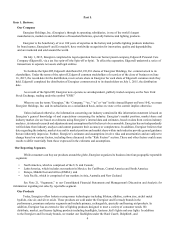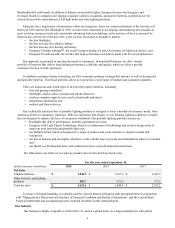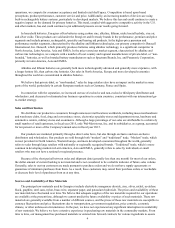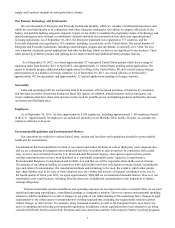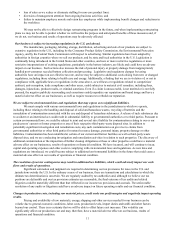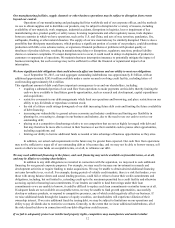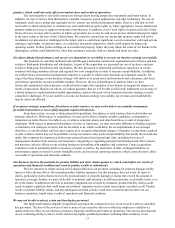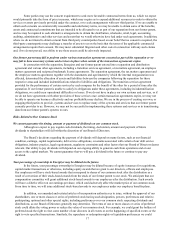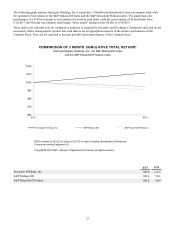Energizer 2015 Annual Report Download - page 18
Download and view the complete annual report
Please find page 18 of the 2015 Energizer annual report below. You can navigate through the pages in the report by either clicking on the pages listed below, or by using the keyword search tool below to find specific information within the annual report.14
management team. Competition for such personnel is intense, and there can be no assurance that we can retain and
motivate our key employees or attract and retain other highly qualified personnel in the future. Additionally, the escalating
costs of offering and administering health care, retirement and other benefits for employees could result in reduced
profitability.
We may experience losses or be subject to increased funding and expenses related to our pension plans.
We assumed pension plan liabilities related to our current and former employees in connection with the separation.
Effective January 1, 2014, the pension benefit earned to date by active participants under the legacy U.S. pension plan was
frozen and future retirement service benefits are no longer accrued under this retirement program; however, our pension
plan obligations remain significant. If the investment of plan assets does not provide the expected long-term returns, if
interest rates or other assumptions change, or if governmental regulations change the timing or amounts of required
contributions to the plans, we could be required to make significant additional pension contributions, which may have an
adverse impact on our liquidity, our ability to comply with debt covenants and may require recognition of increased
expense within our financial statements.
Our credit ratings are important to our cost of capital.
We expect that the major credit rating agencies will continue to evaluate our creditworthiness and give us specified
credit ratings. These ratings would be based on a number of factors, including our financial strength and financial policies as
well as our strategies, operations and execution. These credit ratings are limited in scope, and do not address all material
risks related to investment in Energizer, but rather reflect only the view of each rating agency at the time the rating is issued.
Nonetheless, the credit ratings we receive will impact our borrowing costs as well as our access to sources of capital on
terms that will be advantageous to our business. Failure to obtain sufficiently high credit ratings could adversely affect the
interest rate in future financings, our liquidity or our competitive position and could also restrict our access to capital
markets. There can be no assurance that any credit ratings we receive will remain in effect for any given period of time or
that a rating will not be lowered, suspended or withdrawn entirely by the applicable rating agencies if, in such rating
agency’s judgments, circumstances so warrant.
Risks Related to the Spin-Off
We have no recent history of operating as an independent company, and our historical financial information is not
necessarily representative of the results that we would have achieved as a separate, publicly traded company and may not
be a reliable indicator of our future results.
The historical information about Energizer prior to our separation from our former parent refers to Energizer’s
business as operated by and integrated with our former parent. Our historical financial information prior to our separation
from our former parent is derived from the consolidated financial statements and accounting records of our former parent.
Accordingly, the historical financial information prior to our separation from our former parent does not necessarily
reflect the financial condition, results of operations or cash flows that we would have achieved as a separate, publicly
traded company during the periods presented or those that we will achieve in the future primarily as a result of the factors
described below:
• Prior to the separation, our business was operated by our former parent as part of its broader corporate
organization, rather than as an independent company. Our former parent or one of its affiliates performed various
corporate functions for us, such as legal, treasury, accounting, auditing, human resources, investor relations, public
affairs and finance. Our historical financial results reflect allocations of corporate expenses from our former parent
for such functions, which are likely to be less than the expenses we would have incurred had we operated as a
separate publicly traded company.
• Historically, we have shared economies of scope and scale with our former parent in costs, employees, vendor
relationships and customer relationships. Although we have entered into transition agreements with our former
parent, these arrangements are limited in duration and may not fully capture the benefits that we have enjoyed as a
result of being integrated with our former parent.
• As a part of our former parent, we took advantage of our former parent's overall size and scope to procure more
advantageous distribution arrangements, including shipping costs and arrangements. As a standalone company, we
may be unable to obtain similar arrangements to the same extent as our former parent did, or on terms as favorable
as those our former parent obtained.
• The cost of capital for our business may be higher than our former parent's cost of capital prior to the separation.
• In connection with the separation, we shifted a portion of our business towards exclusive and non-exclusive third-
party distribution arrangements rather than directly selling product to our retail customers. Retail customers who
prefer to buy directly from us may reduce or terminate their purchases from us as a result of this new strategy. In
addition, we cannot ensure that we will be able to negotiate the most advantageous distribution agreements, or that
the third-party distributors will operate under the same standards as we would have or will not take actions that


